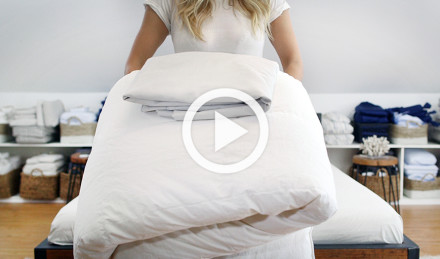No matter what material you prefer for your sheets and bedding, there’s something luxurious about getting into a freshly made bed adorned with crisp, clean sheets.
Yet staying on top of your laundry can be a more significant challenge than you plan for, and sometimes your freshly cleaned sheets linger in the dryer or the hamper a little too long, getting creased and wrinkled. If you wish to harness some of the specially curated luxury of a five-star hotel in your own home, consider changing the steps you usually take when laundering your sheets and making your bed.
The good news is that you don’t have to wash and dry your sheets all over again to get the wrinkles out. There’s an easier way to capture that five-star hotel feeling at home. Let's dig into how to iron sheets to make bedtime so much more comfortable.
Do You Have to Iron Sheets?
Do You Have to Iron Sheets?
While ironing sheets isn’t a requirement for a comfortable bedroom, many people choose ironing as a means to unwrinkle sheets and bedding. If you don’t mind a lived-in, rumpled-feeling bed, then you can put new sheets on straight out of the dryer or from the linen closet and save the effort.
If instead, you prefer that brand-new hotel bed feeling, read on to learn helpful tips for ironing sheets properly!
Why Iron Sheets?
Choosing to iron sheets offers a few perks beyond a fresh, clean appearance. Ironing your sheets can actually make them feel softer if they’re new or have been sitting folded up and unused in a linen closet for a while.
If you have guests coming and you want to present a tidy, welcoming guest room, spending a few minutes ironing the bed sheets can also make a big difference. Choosing to iron pillowcases even if you can’t iron the full set of sheets is also a nice touch.
Some people believe that ironing sheets will help remove any bacteria or germs that may have survived your wash cycle, but in order to kill bacteria, you would need to iron sheets at a high temperature, which isn’t recommended for many bedding fabrics.
How to Iron Sheets Easily and Effectively
How to Iron Sheets Easily and Effectively
If you’re wary of adding more time or effort to your cleaning and laundry routine, it’s important to know the best ways to iron sheets. Because the ideal technique depends on the type of sheet and fabric material, we’ll first talk you through the general step-by-step instructions for ironing sheets, then provide some important fabric-specific considerations.
Ironing Sheets Step By Step
1. Start by laundering your sheets according to the care instructions on the label. After washing, pop your sheets in the dryer and tumble dry on low or hang your sheets on the line until they’re only slightly damp. If your washer has a powerful spin cycle, the final spin may dry your sheets sufficiently and you can skip to the next step.
2. Some people prefer to spray their damp sheets with starch for a crisper finish. This is optional and may not be ideal for all fabrics because it can shorten your sheets’ life expectancy by weakening the flexibility and tensile strength of the fabric. Again, it’s wise to refer to your sheets’ care instructions!
3. Set your iron to the appropriate temperature for your fabric. Test a small area of fabric the first time you iron a new set of sheets to make sure you don’t overheat the fabric or burn it.
4. When ironing the fitted sheet, avoid the elastic portions and work section by section. The larger your ironing board is, the easier this will be. Make sure you don’t crease the sections you’ve already ironed by clumping the fabric too much.
5. To iron a flat sheet, you can fold it in half vertically for a more manageable size.
6. Iron out any creases you may have created when folding your sheets. For stubborn creases, you can use a spray bottle with some water to rewet the crease for a fresh start.
7. After ironing the fitted sheet, top sheet and pillowcases, make the bed right away so new creases don’t have a chance to settle in!
Because each type of bedding has its own specific care guidelines and recommendations, make sure you refer to these helpful fabric-specific on how to iron sheets:
How to Safely Iron Cotton Sheets
Cotton is usually one of the most forgiving and simple fabrics to iron, though if you have organic or specialty cotton sheets, it’s important to take extra care to follow the washing instructions provided by the manufacturer.
For the softest cotton sheets, it's best to select your washing machine’s delicate cycle with a cold, cool or warm temperature. Avoid using fabric softener, bleach or harsh detergents.
You can iron cotton sheets at a higher temperature setting than you’d use with other fabrics. Try using a medium to high temperature. If your iron has a cotton setting, that’s a great place to start.
For more specific instructions on washing organic cotton sheets to maintain their eco-friendliness and quality, read our guide: How to Wash, Dry and Care for Organic Cotton Sheets, Towels and Clothes
How to Safely Iron Linen Sheets
When caring for linen bedding, a lower temperature is often best for avoiding shrinkage and fiber damage. If you can set your washing temperature manually, aim for between 40 to 60 °F. Otherwise, a lukewarm, warm or cool temperature will work well.
For another tip on how to iron sheets made of linen, set the temperature on your iron to something on the cooler side to avoid overheating the fabric. When ironing linen, a slight downward and outward pressure for gentle stretching is effective. Because the temperature is lower, ironing linen sheets will take a bit longer to complete.
For more information on proper care for linen sheets and bedding, read our helpful guide: How to Wash, Dry and Care for Your Linen Sheets
How to Safely Iron Percale Sheets
Percale bedding is best washed with a cool temperature and gentle detergent to avoid pilling and fabric damage.
Ironing isn’t typically recommended for percale because the heat can vastly diminish your bedding’s lifespan. If you prefer to iron your percale bedding, use the lowest temperature possible and make sure your bedding is still fairly damp.
If wrinkled percale is a common frustration for you, but you’d rather not iron your sheets, you can put your percale sheets on the bed while they’re still a little bit damp. Just make sure you leave plenty of time for them to finish drying before you slip into bed!
To learn more about how to iron sheets made of percale, along with other care instructions for this delectable fabric, take a look at this guide: How to Wash, Dry and Properly Care for Percale Cotton Sheets
Ironing Other Sheet Materials
Man-made fabrics like polyester and blends are less prone to wrinkling than all-natural fabrics so you may not need to iron sheets and bedding made of these materials. If you do decide to iron these fabrics, pay attention to the care instructions and always use the iron heat setting designed for that particular fabric.
For more general sheet washing tips to keep them fresh and in good shape, explore the How to Wash & Properly Care for Bedding guide.
Other Considerations When Ironing Sheets
Now that we’ve covered the basics for how to iron sheets and a range of other bedding fabrics, here are a few other helpful tips to consider for a wrinkle-free bed.
Do You Need a Full Size Ironing Board?
A full-size ironing board is best for ironing sheets. If you don’t have a full-size ironing board available, you’ll quickly find that using a miniature or dorm-size ironing board is slow, frustrating and inefficient. Instead, try laying a large bath towel on the kitchen counter or table as a makeshift ironing board. Keep the iron moving and use a low temperature to avoid damaging the table or countertop.
Can You Iron the Sheets While They’re on the Bed?
Other Considerations When Ironing Sheets
Now that we’ve covered the basics for how to iron sheets and a range of other bedding fabrics, here are a few other helpful tips to consider for a wrinkle-free bed.
Do You Need a Full Size Ironing Board?
A full-size ironing board is best for ironing sheets. If you don’t have a full-size ironing board available, you’ll quickly find that using a miniature or dorm-size ironing board is slow, frustrating and inefficient. Instead, try laying a large bath towel on the kitchen counter or table as a makeshift ironing board. Keep the iron moving and use a low temperature to avoid damaging the table or countertop.
Can You Iron the Sheets While They’re on the Bed?
Though you probably could iron sheets on some types of mattresses safely, there are plenty of things that could go wrong in the process.
Mattresses are made of a range of materials, from organic cotton to memory foam. Certain materials have low heat resistance and can actually melt if you attempt to iron sheets directly on them.
To be on the safe side, it’s wise to protect your mattress and iron the sheets while they’re off the bed.
Keeping Your Sheets Wrinkle Free Without Ironing
To avoid heavy creases from setting in, always fold sheets that you intend to store in a linen closet as soon as they come out of the dryer. When it's time to change the sheets, toss them in the dryer again with a couple of wool dryer balls and tumble them on a low setting to knock out any creases.
High Quality Sheets and Bedding for Long Lasting Use
No matter what material you prefer for your bedding, selecting high-quality products and closely following the manufacturer’s care instructions will always result in a longer lifespan for your sheets, blankets and other bedding.
Whether your ideal bedroom is plush with percale, filled with crisp cotton or features luxurious linen, an investment in top quality bedding is its own reward. Freshly ironed sheets are just the icing on the cake!
Read on:
Household Chore List: Daily, Weekly, Monthly Chores Around the House
Laundry Room Essentials: Everything You Need for Doing Laundry
When to Replace Sheets, Pillows, Blankets, & More Household Essentials
When to Replace Towels, Bath Mats, Shower Curtain Liners, & Other Bath Essentials
How to Recycle, Reuse, & Donate Old Sheets, Blankets, & Towels
High Quality Sheets and Bedding for Long Lasting Use
No matter what material you prefer for your bedding, selecting high-quality products and closely following the manufacturer’s care instructions will always result in a longer lifespan for your sheets, blankets and other bedding.
Whether your ideal bedroom is plush with percale, filled with crisp cotton or features luxurious linen, an investment in top quality bedding is its own reward. Freshly ironed sheets are just the icing on the cake!
Read on:
Household Chore List: Daily, Weekly, Monthly Chores Around the House
Laundry Room Essentials: Everything You Need for Doing Laundry
When to Replace Sheets, Pillows, Blankets, & More Household Essentials
When to Replace Towels, Bath Mats, Shower Curtain Liners, & Other Bath Essentials
How to Recycle, Reuse, & Donate Old Sheets, Blankets, & Towels











